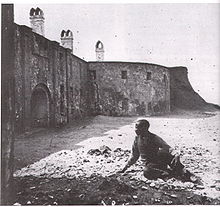Castle Pinckney
Castle Pinckney was a coastal fortification to protect the port of Charleston, South Carolina and is located on Shutes' Folly Island about 1.7 km east of Charleston.
history
In 1794, the order was given to build a fortification on Shutes' Folly Island to protect the port against a possible threat from French troops from the sea, as war against France seemed imminent. The fort at that time consisted only of earth walls that had been reinforced with palm trunks and was only completed in 1797. This first fort was completely destroyed by a severe hurricane in 1804 . 1809 began with the construction of a two-story battery position according to the model as it was built in Fort Massachusetts (Mississippi) and the so-called Battery in Manhattan . In the American-British War of 1812, the fort was occupied with troops, but was not involved in combat operations. After that it stood empty for years and was left to its own devices.
During the so-called Nullification Crisis in 1832 (South Carolina refused to recognize a new customs law enacted by President Andrew Jackson and passed by the United States Congress ), the fort was briefly occupied by US Army troops and the ramparts were reinforced. The garrison was then withdrawn and the fortification was used as a powder magazine and warehouse for military equipment.
During the American Civil War , Castle Pinckney was part of the Charleston Bay and Harbor fortification system that included the stronger Fort Sumter , Fort Moultrie and a number of makeshift field fortifications along the coastline. Until the outbreak of war it was still occupied by Union troops and heavily armed with artillery. In 1860 it had:
- 14 24 pounder muzzle loading cannons
- 4 42 pounder muzzle loading cannons
- 4 8-inch (20.3 cm) howitzers
- 1 10-inch (25.6 cm) mortar
- 1 8-inch mortar
- 4 field cannons to protect the flanks.
On December 27, 1860, a week after South Carolina withdrew from the Union, the South Carolina Militia surrendered and received free retreat. The Union soldiers went to Fort Sumter to strengthen the garrison there under Major Robert Anderson . Castle Pinckney was the first northern military property to be captured by the Confederate States Army . The Charleston Arsenal also surrendered three days later . After the attack on Fort Sumter, the factory was occupied by the Charleston Zouave Cadets . After the first battle of Manassas , the fort briefly took in prisoners of war from the northern states who were housed in the lower casemates . After the prisoners were relocated again, the fortifications were reinforced with earthfills and additional artillery. The fort was not involved in any fighting during the entire war.
In 1890 a small part of the wall and the casemates were removed to build a lighthouse . On the occasion of the Spanish-American War in 1899, the fort was repaired and modernized again.
Castle Pinckney received National Monument status in 1924 through a proclamation by President Calvin Coolidge . However, the US Congress passed a law in 1951 (for whatever reason) that removed the fortification from the list of National Monuments and transferred responsibility to the US Army Corps of Engineers .
In the 1960s, the fort was removed from the military list. It was then taken over by a group of citizens who called themselves Sons of Confederate Veterans for the purpose of maintaining and setting up a museum. After these efforts had to be abandoned due to lack of financial resources, the fort became the property of South Carolina. However, so far very little effort has been made to save the building, which is threatened with decay. Repair work could not be carried out to the extent actually necessary. The plant is left to decay. Access is not possible.
There are still a few muzzle-loading cannons in the fort, which have not been removed because at that time it was not worth the effort to recover the artillery-outdated artillery.
Building
As in Fort Massachusetts, it is a roundabout made of bricks , the base of which forms a little more than a semicircle and which is sealed off in the throat by a hollow traverse as a defensive barracks. The battery pack is pulled around the throat area, so that two semicircular throat cases were formed to protect the entrance area. The complex was not surrounded by a ditch. Guns could be set up covered in the upper level of the casemates . Due to the semicircular design of the work, the direction of fire from south to north was possible, but the fort was oriented to the east towards the strait at Fort Sumter. It was purely an artillery combat plant, because apart from the two throat cases to protect the gate area, there were only minor options for defending against infantry attacks due to the design. The rifle slots were only set up for long-range fire, in close combat they were ineffective because the blind spot took up the entire front.
Naming
The fort is named after a participant in the American Revolutionary War : Charles Cotesworth Pinckney .
swell
Coordinates: 32 ° 46 ′ 25 ″ N , 79 ° 54 ′ 39 ″ W.


